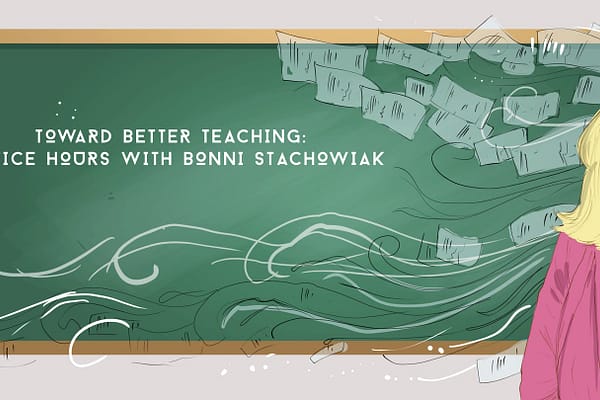
This article on How to Get Students to Join You for Office Hours was originally posted on the EdSurge website and is reposted here with permission. It is part of the guide Toward Better Teaching: Office Hours With Bonni Stachowiak. You can pose a question for a future column here.
Dear Bonni,
I work at a small institution, where the professor/mentor relationship is paramount. I know how essential it is to have students come see us during office hours, but my students just aren’t coming to visit. How do I get more of them to utilize that time with me?
—Sitting alone during office hours, anonymous
The irony isn’t lost on me that I am about to answer a question about getting students to come to office hours, when I can only remember making an attempt to do that twice in my own college years. Once, the professor wasn’t there, so that story ends with me leaving and never giving it another go.
The other example involved me actually coming face-to-face with someone I was very afraid to talk to. I was failing microeconomics and wasn’t sure what to do. One of my roommates was tutoring me, and she suggested that I stop into the professor’s office hours to get a bit more direction.
I still remember the stern look on his face. His eyes were crinkled up. His disappointment seemed so evident. “What did you say your last name was, again?” he asked. After my response, he got up from his desk and told me to follow him. He went to a large file cabinet in a back hall and removed some kind of notebook from one of the drawers.
As he sat back down, he sighed deeply. He asked what my Dad’s name was and if he had gone to the same school I was attending. (He had.) The professor then shared that my Dad had been his student and in fact had even been selected as the business student of the year in the late 60s.
While I was glad to know that about my Dad, I don’t recall getting any new insights about economics during my visit. Fortunately, my roommate’s help continued and I managed to pass the class. I never visited another professor during their office hours. It never occurred to me that it was part of their job. Or that some of them might actually enjoy the experience. Yet, here I am to offer a few suggestions of some approaches to try that might have brought me back for more when I was in college.
Start with Small Steps to Set the Stage
This first set of ideas fall into the category of what I will call Setting the Stage. None of these approaches require getting permission from anyone to try them out. These small steps can help more students benefit from the experience of office hours.
Be Welcoming
One of my colleagues, Roger Heuser, a professor of leadership studies at Vanguard University, regularly invites people to join him in his office for tea. He has a box of all these different types of teas from around the world and a set of fancy teacups. The whole experience has left me feeling like our conversation was the most important thing to him in those moments and that the time was sacred. No incoming text messages interrupted what either of us had to say. I felt welcome and affirmed.
I have been meaning to attempt to replicate this same tea experience in my own office hours. However, I have only gotten as far as trying to find some good teacups on Amazon and considering purchasing a wooden box for a tea collection. Instead, my attempts at being welcoming involve leaving my door open during office hours, giving a warm smile and greeting the person, and moving out from behind my desk to a different seating area for conversations with students.
Show Transparency
The Transparency in Learning and Teaching (TILT) project encourages professors to help students understand how they learn and pull back the veil on the teaching and learning process The model advocates using a three-part approach to transparency. Each assignment should have a clear purpose, a description of the task, and associated criteria for how the work will be graded.
We should bring that same emphasis on transparency into office hours. Be clear with students about the purpose of office hours in the syllabus and each time an invitation is extended to join you. Establish a clear and easy sign-up process. Finally, communicate what students can expect when they decide to take advantage of office hours with you.
Structure Time for Scaffolding
Consider encouraging students to use office hours as a time to “scaffold” assignments. Just as scaffolding is used in physical construction to hold the structure up as it is being built, the office hour can be a place for students to bring in their work for input before it is complete.
For instance, if you have assigned a paper, invite students to come into your office with an idea and a brief outline, so you can talk through it together.
Some professors require this as a component of an assignment, though I would caution against using coercion too heavily, as you are trying to give the perception that office hours are inherently valuable. Otherwise, you are just building in another box students feel they are required to check.
Invite Groups
It can also help to welcome groups of students into office hours. This often results in students feeling less fearful when they are in the room with others they perceive to be in similar situations. If a student is struggling in your class, it can be helpful to realize there are others also having challenges learning the material.
Or Try These Bigger Ideas
These next set of possibilities may not be common practice yet, so you may want to talk with colleagues about how to experiment with these options while still fulfilling the requirements at your institution.
Go Virtual
Stefan Still, an associate professor of chemistry at the University of Washington, has shared previously on EdSurge about his success at taking his office hours online. He has been skeptical about bringing technology to teaching, out of concern that it can bring too much focus to impersonal aspects of teaching. However, he has found that having students join him virtually for office hours has extended his reach beyond what was possible with in-person meetings.
Another advocate for the power of virtual office hours is Zhaoshuo Jiang, assistant professor of civil engineering at San Francisco State University. On an episode earlier this year of the Teaching in Higher Ed podcast, he indicated that, “The main goal of teaching is not only to help the student inside the classroom, but also outside the classroom.” He invites his students to set appointments using the YouCanBook.me scheduling service, allowing them to not just select a date and time preference, but also to specify whether to meet in person or virtually.
Eat, Walk, Move
It can be quite helpful to remove ourselves from the office part of office hours altogether. Viji Sathy, a teaching associate professor and program evaluator of chancellor’s science scholars at the University of North Carolina at Chapel Hill, encourages us to be more inclusive in how we approach office hours by using different formats, times and locations. She gets herself in the contexts in which her students spend their time, instead of expecting them to come to her. She shared these approaches on her website, and also discussed them on an episode of the Teaching in Higher Ed podcast.
Get Yourself a Robot
At San Francisco State, Jiang has gone even further to shake up his office hours. He literally has a robot set up and ready for students to use during their virtual visits. He uses the Double 3, a two-wheeled robot that can be controlled by students via an app on their phone. It’s essentially a gimmicky way to do a video chat, with the webcam attached to the robot so that students can change their view by moving the robot around the office as they converse.
Yes, for the vast majority of us, a robot is probably not in the picture. However, the idea of doing something unique that shows a student we care and are here to support them helps a lot.
Whether you welcome someone in for a cup of tea, or meet them in the library for a chat, office hours can make a world of difference for our students.
Photo credit: Christopher Gower on Unsplash




I’ve found that no matter when I schedule my office hours, many students are not available. I can’t be endlessly available, and in addition, many students seem to make the decision to ask to meet at the last minute, after my office hours are over for the week. I offered a 10-minute version of Dr. Sathay’s “We Greet” last semester for students in my online class, and met about 50% of my students in the first 2 weeks. They seemed more likely to reach out to me to ask questions the rest of the semester, by email or test. I also saw an uptick in positive comments on the evals about my helpfulness. I haven’t tried the meet and greet with face-to-face students, but perhaps I should. Is the idea of “office hours” passe?
These are some great ideas. I can’t stress enough how being welcoming and inviting are very vital. If an instructor isn’t personable in class then students won’t want to go visit them during office hours. In my experience I had many professors require students to come visit them. Some were great and inspirational, some were horrible and made me question my academic decisions. I really like the idea of tea time and groups a lot. Both would be a great way to lower anxiety and allow for better communication.